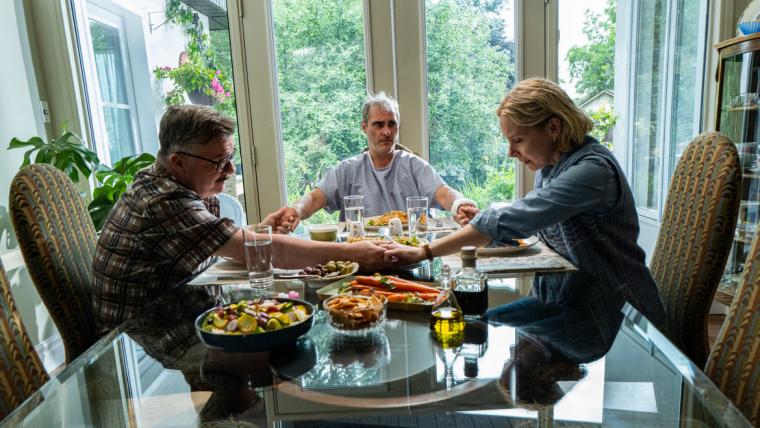
Nathan Lane, Joaquin Phoenix, and Amy Ryan in Beau Is Afraid
Running just shy of three hours and boasting all of its creator's evidently favorite touchstones that include foreboding A-frame houses, headless corpses, and full-frontal nudity for characters you don't necessarily want to see naked, writer/director Ari Aster's Beau Is Afraid is one of those movies that naturally engenders a “love it or hate it” tag. Yet while I can easily imagine audiences either adoring or loathing Aster's impassioned, insanely ballsy (in more ways than one) fever dream, I would argue that it's actually incredibly easy to fall into a middle camp: acknowledging the presentational greatness while also admitting that, in the end, it's a meandering, deeply confused wreck. That doesn't mean, however, that I left my screening unsatisfied. I was satisfied and then some, even if I won't pretend to understand what precisely happened. I'm not sure that Ari Aster does, either.
Beau Is Afraid finds Joaquin Phoenix's title character traveling to his mother's house, arriving at his mother's house, and leaving his mother's house. That's the movie's entire plotline, and it could just as readily apply to Charlie Kaufman's I'm Thinking of Ending Things from 2020. But if you remember that deliriously weird-ass Netflix release, you know that this simplest of narrative structures barely hints at the truckload of absurdities that Kaufman packed into his indescribable road trip – a work that, at any point, could veer into comedy, or tragedy, or horror, or ennui, or any combination thereof. Aster's film, astonishingly, is an even stranger concoction.
Although none of it feels “real,” per se, there are definitely moments, and even whole sequences, in which Aster's heavily symbolic, dream-logic presentation gives you a fleeting sense of certainty. “Ah,” you think, “this is about an agoraphobic's fear of leaving his house!” Or “This is about a middle-aged mama's boy's inability to please his mama!” Yet every time you presume to have a concrete handling on what's transpiring here, Aster either completely demolishes your hypotheses or immeasurably expands them in the manner of a particularly cruel and relentless sketch-comedy improviser. “Beau loves his mother.” “Yes … and?” “And he also kind of hates her.” “Yes … and?” “And he really wants to see her.” “Yes … and?” “And he's doing everything possible to make that not happen.” “Yes … and … ?!?” And on and on for three hours.
That might sound draining. Yet while I've seen a number of better, certainly less confounding films this year, I can't think of one that kept me so firmly transfixed from scene to scene. Admittedly, my laser focus was occasionally due to just trying to figure out what on earth was going on, and if you can explain why Beau feels so personally connected to an outdoor stage piece that doesn't appear to have any connection to his own life – a play that he projects himself into as its endlessly roving protagonist – you're far more intuitive than I. More frequently, though, I was simply, joyously flabbergasted by the breadth and scope of Aster's achievement, as well as his increasing ability – previously demonstrated in Hereditary and Midsommar – to successfully blend the hilarious and the nightmarish.
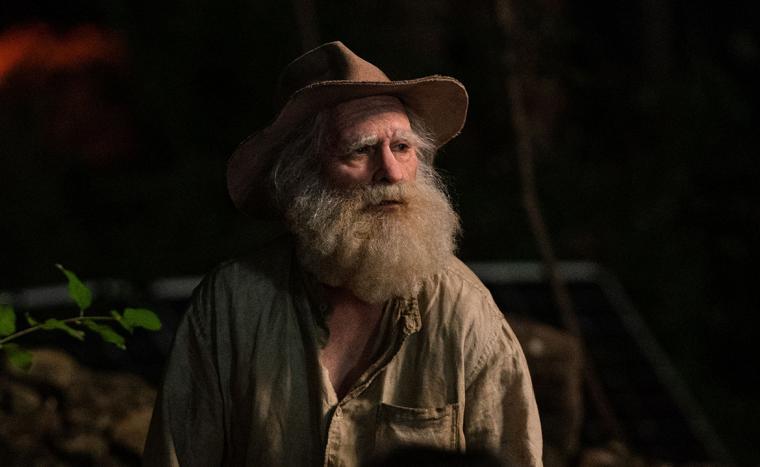
The film is bookended by serenity. At the start, it's in the office of Beau's therapist (Stephen McKinley Henderson) who patiently listens to his paranoid, panic-stricken client and writes a single word on his notepad: “Guilty.” At the end, it's in an enormous amphitheater, or perhaps a coliseum, as patrons quietly exit and the only sounds come from the gentle burbles in a pool. (Allow me a sidebar shout-out to my awesome 20-or-so fellow moviegoers on Thursday evening – none of whom appeared incensed by the Ari Aster weirdness or stormed off in a huff, and all of whom stayed through every single end credit before the lights came up.) Between those moments of calm, however, are four lengthily extended sequences littered with flashbacks, dreams, and probable psychotic breaks that amuse and terrify in roughly equal measure.
Segment one involves Beau's seemingly impossible task of leaving home to visit his mother Mona (Patti LuPone in the present, Zoe Lister Jones in the past). Beau wants to see her, or says he does, but the comically irrational bevy of crime outside his apartment – muggings, maulings, a naked madman wielding a knife – appears personally designed to thwart him. Segment two finds Beau finally escaping his urban hellscape and settling, for a time, with a suspiciously helpful upper-middle-class couple (a spectacular Amy Ryan and Nathan Lane) whose son died in combat and who seem at least moderately interested in having Beau join the clan. The third segment takes place, in the manner of so many Grimm fairytales, in a forest, where a traveling theatre troupe performs that aforementioned drama that captures Beau's soul. And in segment four, we finally reach Mona's place – an almost unspeakably beautiful, three-story domicile of wood and glass that boasts discomforting hints to Beau's past, narrative clues in hallway wall photos, and, most enticingly of all, the sublime Parker Posey.
It would be unfair to give away what ultimately occurs in any of the film's four distinct portions. All of them, though, are suffused with breathless immediacy and undeniable threat, and all of them are jam-packed with mordantly funny details, whether Beau is staring at a sweaty stranger above his bathtub, or Ryan's suburbanite is solving the jigsaw puzzle of her dead son's portrait, or Beau is facing the possibility, in deep middle age, of experiencing his very first orgasm. With Phoenix offering a fearless, exhaustive, sometimes exhausting portrayal, Beau Is Afraid is clearly about any number of things – conflicted parental relations, fear of abandonment, unease over sexual release, guilt guilt guilt – and it may take several more viewings to see if its creator comes close to clarifying his intentions. But does he even need to? One of the major pleasure of movies lies in the chance to be taken on a voyage, and for three hours here, we seem to be given an express-train ride through Ari Aster's psyche. It's a nutty place to visit. I'm thrilled to not live there.
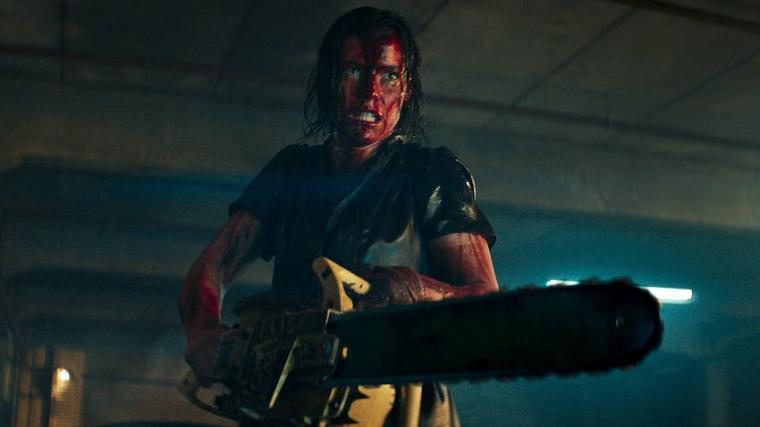
EVIL DEAD RISE
About halfway through Evil Dead Rise, the first reboot/sequel/whatever to Sam Raimi's seminal horror-comedy series since Fede Alvarez's largely unfortunate Evil Dead in 2013, I reacted in a way that writer/director Lee Cronin no doubt wouldn't have appreciated: I yawned. This latest tale of an unholy incantation releasing a bloodthirsty entity did, after all, feature five potential victims under the age of 18, and if we horror fans have learned anything in the progressively-more-squeamish years since The Shining gave us a pair of butchered twins, it was that kids in these things – barring rare exceptions such as 13-year-old Charlie in Ari Aster's Hereditary – generally wind up traumatized, but at least alive. Then the possessed monster in Cronin's 2023 continuation threw a pre-teen against a wall and, for a long while after, left him there, the boy's sad, crumpled corpse viewed as a blurry background image while his grinning murderer stared at us through an apartment-door peep-hole. O-o-o-okay, I thought. This movie isn't fooling around. And it isn't. That's both the best and worst thing about it.
To get the “worst” out of the way, Cronin's film shares the chief detriment of Alvarez's, which is to say: Where's the funny? No one's demanding the laughs-per-shrieks ratio of Raimi's unremittingly groo-vay Evil Dead II, but a few jokes here and there would hardly have been inappropriate for a concept this objectively silly. Instead, the movie is almost diabolically serious-minded, with the travails of Lily Sullivan's newly pregnant roadie Beth and Alyssa Sutherland's recently abandoned tattoo artist Ellie casting an uneasy pall on the proceedings well before the latter turns into the mommy from hell. (At one point, Cronin basically re-stages the flying-eyeball-in-the-mouth bit from Evil Dead II, yet incredibly, the moment isn't designed as a gross-out gag. It's merely gross.) If you're a splatter-flick fan, you can find some amusement in the veritable oceans of blood that wash over the screen, and I certainly giggled during the finale at the sheer tonnage of viscera that Cronin served up for our delectation. Still, it's hard to find much genuine mirth in a movie that spends so much time threatening and even exterminating the lives of minors … though that nastiness did come with perks of its own.
Once it became clear that Cronin had no compunction about offing every member of his small cast, no matter how young, I didn't even consider yawning, and the freaked-out performances of Morgan Davies, Gabrielle Echols, and the diminutive heartbreaker Nell Fisher are every bit as wrenching as that of the grave, stalwart Sullivan. Not every director who's adept at horror composition and framing is as strong with actors as Cronin appears to be, and his work with the kids here is inspiring. It would also be the film's chief takeaway if Sutherland weren't so utterly unnerving as the demonically motivated Ellie. Despite the frequent ingenuity of Cronin's shock effects, I can't say that Evil Dead Rise was all that scary. Creepy, though, it most definitely was, and the many gallons of goo weren't nearly as memorable as the fiendishly wide grin that Sutherland's possessed Ellie sports, especially during the scene in which her sugar-sweet prompting of her youngest daughter gets the poor girl to unlock the front door. Sutherland is extraordinary in Cronin's film, and her fiendish look deserves an Oscar. Granted, a ridiculously gruesome Evil Dead entry may never be the Academy's cup of tea. But after five consecutive years of the Best Makeup & Hairstyling trophy going to whichever movie put its star in the most realistic fat suit, aren't we all up for a gory change of pace?
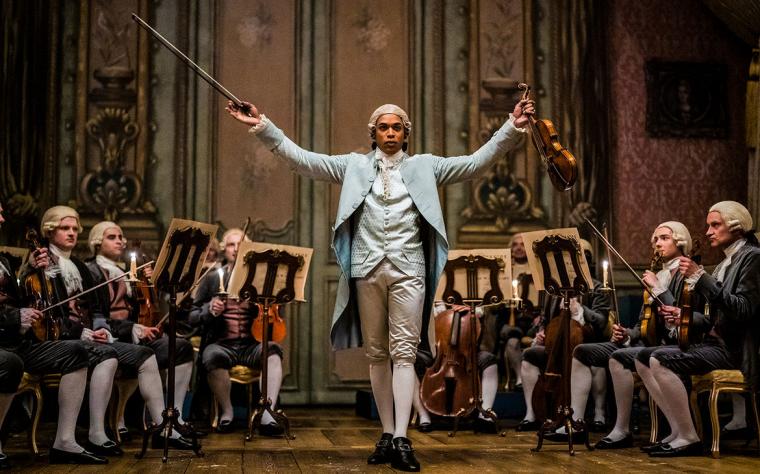
CHEVALIER
A biographical drama about the little-known French-Caribbean musician Joseph Bologne – an 18th-century Black man belatedly recognized as a noted composer, violinist, and revolutionary – director Stephen Williams' Chevalier finds its hero charming Marie Antoinette, enraging Christoph Gluck, and embarrassing the hell out of Wolfgang Amadeus Mozart. Despite the presumptive juiciness of these encounters, Williams' movie isn't a load of laughs, nor is it designed to be. But I will admit to letting loose one instinctive, inappropriate cackle midway through the film when Kelvin Harrison Jr.'s Bologne gently yet forcefully berated his Senegalese birth mother for speaking in her native tongue, the acclimated nobleman telling his long-absent mom, “French is the preferred language here.” Not a funny line on its own. But hilarious when, in the manner of myriad Masterpiece Theatre-style flicks set in France over the decades, delivered by Bologne in a posh accent that's pure upper-class England.
Because so many previous works are guilty of this same crime against dialects, I'm not going to bash Chevalier for being one of them, and as someone who will forever place Miloš Forman's Amadeus on his list of all-time-favorite movies, screenwriter Stefani Robinnson's consistently anachronistic dialogue gets let off on a pass, too. Yet unlike in Amadeus and loads of additional entertainments that this period-porn blatantly steals from (most consistently Baz Luhrmann's Moulin Rouge!), the performers here don't provide one surprising or spontaneous-seeming reading or action among them. A gifted actor and magnetic screen presence, Harrison does what he can to make Bologne distinct – being granted a goodly amount of Cyrano de Bergerac haughtiness certainly helps – and Samara Weaving, Lucy Boynton, Minnie Driver, and Sian Clifford are watchable and look smashing in their corseted attire. None of them, however, is able to overcome the dreary predictability of Robinson's script, to say nothing of its tiresome pandering. One scene after another boils down to Bologne doing something marvelous, some stuffy British – sorry, French – nobleperson minimizing his talents with a variant on “But … you're black!”, and the audience goaded into tsk-ing and harumph-ing the attitudes of a less enlightened age. It's a movie for viewers who love nothing more than taking the moral high road and back-patting themselves for not being as bigoted as people who lived 300 years ago.
Still, even though I found Williams' movie an occasionally offensive snooze, it's not hard to see why others wouldn't. The music is pretty. The costumes are pretty. The lighting is pretty. And for those who tire of all the sedate loveliness, myself included, at least there's Ronke Adekoluejo as Bologne's mother Nanon, a former slave to her son's father who is decidedly not wowed by her child's staggering success in a white world. Adekoluejo is as hindered by the movie's narrative straightjacket as her castmates are. Yet she alone suggests a living, three-dimensional person, Nanon's anger and fierce heartbreak bleeding through the aggressively tidy, Miramax-in-the-'90s presentation. “Pretty” has its merits, but the story behind Chevalier demanded a lot more ugly.
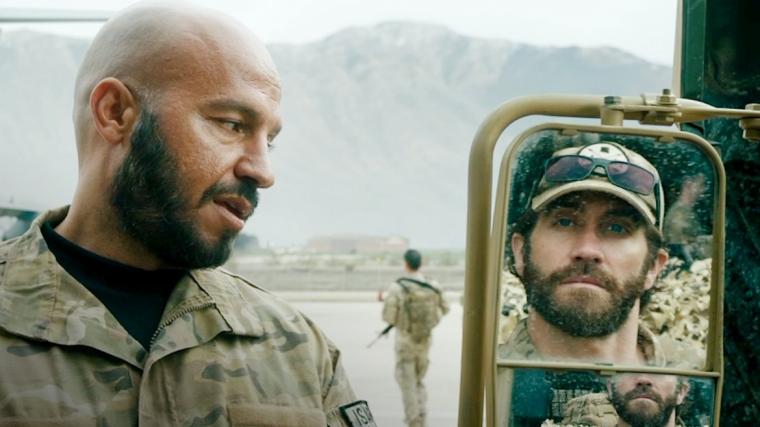
GUY RITCHIE'S THE COVENANT
As Chevalier reminded me, it can be intensely (if unsurprisingly) disheartening to see a “based on a true blah blah blah” movie that doesn't feel true for an instant. It's rare, however, to find that sadly familiar scenario's direct opposite: a movie that goads you into thinking it's factual while being a complete work of fiction. Much of the action thriller Guy Ritchie's The Covenant, most of which is set overseas during the War on Afghanistan in 2018, plays like a ripped-from-recent-headlines saga, telling of how an Afghan interpreter (Dar Salim's Ahmed) saved the life of Sergeant John Kinley (Jake Gyllenhaal) by surviving several days, and innumerable personal threats, hauling the man's body to safety through the desert. A great deal of Ritchie's latest is indelibly moving and exciting, and Ritchie's unmistakably righteous anger is legitimately affecting. Yet when the end credits were accompanied by images of actual military men smiling next to their actual Afghan interpreters, and it became clear that Ahmed and Sergeant John weren't based on real people, I felt weirdly cheated, and almost pissed at the perceived subterfuge. Throughout the film's two hours, I gave The Covenant's dubious narrative a lot of suspension-of-disbelief leeway. But how are we to feel when dramatic events that seemed too-Hollywood in the moment really were too-Hollywood, and apparently included to entice reactions that would've likely been elicited without such arm-twisting narrative fakery?
To be fair, Ritchie's first film since Operation Fortune: Ruse de Guerre debuted a month-and-a-half ago doesn't open with one of those “This is a true story” title cards. It plunks us right into the thick of its Army troops' daily hunt for the Taliban, or at least a possible location for their stash of artillery. Yet with the first appearance of every member of Sergeant Kinley's team, and there are more than a half-dozen of them, their names, positions, and even nicknames are presented via accompanying title cards, suggesting that this was information not be be forgotten. By the fourth or fifth time this happened, it began to seem overwhelming, and even somewhat laughable: Were we expected to actually remember all of these guys' names when they're mostly seen in group shots and are dressed exactly alike? The reason we don't laugh, though, is because we rightly assume that including their names is Ritchie's way of honoring these real-life soldiers who will – as we know from the movie's trailers – soon be deceased. Yet they're not real-life soldiers. They're creations of screenwriters Ritchie, Ivan Afkinson, and Marn Davies. And they're gone from the film before it's a half-hour old. So again: Why include those identifying title cards in the first place? If not, that is, to hoodwink us into believing this story to be true?
Consequently, Guy Ritchie's The Covenant winds up being something very strange: a movie that's more disappointing in reflection than in practice. There was a lot about the film that I admired: the gracefulness of Gyllenhaal's and Salim's byplay, much of it unspoken; the harrowingly staged sequence of Ahmed being interrogated by the Taliban while Kinley lies hidden in his truck; the unsentimental, guilt-induced reasoning for Kinley needing to return to Afghanistan to find his now-targeted interpreter. (“You think he blessed you?” John asks his wife after being safely returned to their California home. “Well, he f---ing cursed me.”) But there was also just enough that read as screenwriting conceits – the only-in-the-movies escapes, the predictably mealymouthed higher-ups, the finale that suggested nothing so much as the climax to Toy Story 3 – to pull me out of the experience. Discovering that they were screenwriting conceits just made the bad stuff worse. If, however, you enter the film knowing in advance that it's fiction, you'll likely have a much better time, and Ritchie's technical prowess and laudable work with his leads makes it understandable that this would be the first of his releases to be graced with his name baked into the title. It sure could've been worse. Twenty-three years ago, we might've been invited to view Guy Ritchie's Snatch.

SOMEWHERE IN QUEENS
If you're a movie lover who's also a dyed-in-the-wool fan of Laurie Metcalf, you're pretty much forced to be patient. While this tireless stage performer can seem like a ubiquitous TV presence thanks to The Conners, guest spots on other series, and occasional scene-stealing work elsewhere (including her fabulous turn in last year's outstanding miniseries The Dropout), Metcalf doesn't show up in many feature films. Since her Oscar-nominated portrayal in 2017's Lady Bird, for example, she's appeared in precisely one – and by “appeared,” I mean her fourth vocal credit as “Andy's Mom” in the most recent Toy Story. So it was with almost ridiculous excitement that I caught Ray Romano's cinematic writing/directing debut Somewhere in Queens, in which my longtime favorite female actor was second-billed as Romano's brassy Italian-American spouse. Truth be told, I was just hoping the movie wouldn't be an insult to Metcalf's talents – that she wouldn't simply be cast as The Wife with no agency or solid jokes of her own. Great news: Metcalf's Angela is a fully-formed, complex, touching, riotous figure who stands completely independent of Romano's Leo and is given the film's final, hysterical punchline, to boot. Even-better news: Not only does Romano's debut deserve Laurie Metcalf, but she completely deserves it.
I suppose it was inevitable that Romano's first foray into feature-film directing would be indistinguishable from a big-screen sitcom, and this one is most specifically focused on Leo and Angela's son Matthew “Sticks” Russo (the magically right Jacob Ward), a phenomenally gifted basketball player and cripplingly introverted high-school senior. Leo wants him to go to college, Angela wants him to stay home, and Sticks, these days, only wants to hang with his girlfriend Dani (the utterly winning Sadie Stanley), whom the kid's parents were previously unaware of. As in the manner of all sitcom movies, there are additional narrative detours: Leo feels emasculated by his father (Tony Lo Bianco) and more successful younger brother (Sebastian Manascalo) and considers a fling with a beautiful divorcee (Jennifer Esposito); Angela refuses to join a support group following her recent bout with cancer; Leo's mom (June Gable) won't stop cooking meatballs. But the Sticks angle gets the most attention, and while the majority of Somewhere in Queens unfurls in a perfectly pleasant network-TV comfort zone despite the gleefully R-rated language, this plotline, happily, doesn't, because Romano and co-screenwriter Mark Stegemann have the nerve – and the good sense – to explore their sitcom figures honestly.
There's enough legitimate surprise built into the narrative that I don't want to give away the goods, and my hunch is that this under-the-radar indie will find a delightfully surprised audience when it eventually starts streaming (probably really soon). Yet as formulaic and squishy as much of Romano's film is, it has teeth and claws – characters here are capable of true pettiness, and meanness, and choices that are frankly unconscionable … if, of course, also pretty easily forgiven. There's honest depth to the characters here, even if it's only sitcom depth, and your opinions of them are unexpectedly fluid; Leo seems like a typically, endearingly Romano-ian schlub until he makes a disastrous offer that can't be ignored. Though it's filled to brimming with likable performers and oftentimes very funny in laugh-track-ready ways, Somewhere in Queens is also sincerely moving, and earns bonus points for giving Laurie Metcalf the second-best role on her not-nearly-long-enough screen résumé. After Angela exchanges smiling pleasantries with the girl who leaves riding piggyback on her son, Metcalf takes a perfect pause before deadpanning “I don't f---in' like her.” Maybe not, Laurie. But we sure like you.










